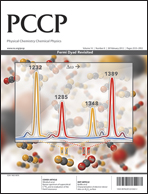Time-resolved emission and absorption spectroscopy are used to study the photoinduced dynamics of forward and back electron transfer processes taking place between a recently synthesized series of donor–(π-spacer)–acceptor organic dyes and semiconductor films. Results are obtained for vertically oriented titania nanotube arrays (inner diameters 36 nm and 70 nm), standard titania nanoparticles (25 nm diameter) and, as a reference, alumina nanoparticle (13 nm diameter) films. The studied dyes contain a triphenylamine group as an electron donor, cyanoacrylic acid part as an electron acceptor, and differ by the substituents in a spacer group that causes a shift of its absorption spectra. Despite a red-shift of the dye absorption band resulting in an improved response to the solar spectrum, smaller electron injection rates and smaller extinction coefficients result in reduced dye sensitized solar cell (DSSC) conversion efficiencies. For the most efficient dye, TPC1, electron injection from the hot locally excited state to titania on a time scale of about 100 fs is suggested, while from the relaxed charge transfer state it proceeds in a non-exponential way with time constants from 1 ps to 50 ps. Our results imply that the latter process involves the trap states below the conduction band edge (or the sub-bandgap tail of the acceptor states), localized close to the dye radical cation, and is accompanied by fast electron recombination to the parent dye's ground state. This process should limit the efficiency of DSSCs made using these types of organic dyes. The residual, slower recombination can be described by a stretched exponential decay with a characteristic time of 0.5 μs and a dispersion parameter of 0.33. Both the electron injection and back electron transfer dynamics are similar in titania nanoparticles and nanotubes. Variations between the two film types are only found in the time resolved emission transients, which are explained in terms of the difference in local electric fields affecting the position of the emission bands.

You have access to this article
 Please wait while we load your content...
Something went wrong. Try again?
Please wait while we load your content...
Something went wrong. Try again?


 Please wait while we load your content...
Please wait while we load your content...